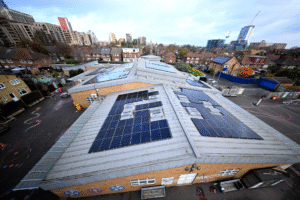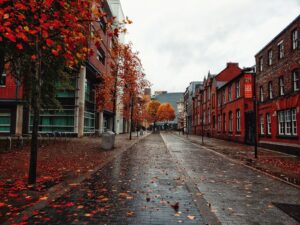City parks and gardens are essential for cooling, calming and cleaning the built environment. We take a closer look at Grosvenor Square, London, where work is underway to create a resilient area capable of serving communities and delivering climate change mitigation.
From droughts increasing the risk of waterborne and foodborne diseases, to heat-related deaths among those over 65 rising by 70% in two decades, the reality of climate change on communities across the globe is unavoidable.
In London, summers are expected to become hotter and drier, and the city is one of countless across the globe now bracing for intensifying heatwaves. With this in mind, we must look at how our urban environments serve the people who live in them. If cities are to remain not just habitable but liveable, our approach to how we create and design green spaces must change.
Urban resilience has traditionally focused on buildings and how to retain heat, while protecting against flooding and other climate-related challenges. However, as warming becomes a greater issue each year, resilience created by green spaces must be utilised with people and nature at the heart.
Our parks, gardens, and green spaces in cities are some of the most valuable public assets we have. They serve communities in a number of ways, from children’s play areas, a place for neighbours to meet, cultures to mix, and local relationships to grow. However, too many of these spaces are designed for aesthetics alone.
Pleasant to look at, but ineffective in combatting rising temperatures and wetter winters, which in London, as in many places, are increasing. It’s time to move beyond traditional views of green spaces and embrace their potential as vibrant, multifunctional assets that support communities, but also biodiversity, and climate resilience.
What if green spaces in our cities became everyday superheroes – cooling, cleaning, calming, and connecting? What if a local park brought down temperatures in the streets around it, supported pollinators, reduced flooding, absorbed carbon and still offered shade, serenity, and a sense of belonging for its residents? Far from lofty ambitions, these are necessities in an age where climate change is such a threat.
This approach to green spaces – where beauty, biodiversity, and comfort work together for the benefit of communities – should become the foundation of how we design and safeguard our cities for the future. It’s about creating green spaces that meet the demands of a changing climate, while enhancing the everyday lives of people who rely on them most.
At Grosvenor Square in London, we’re demonstrating how this can work and look in practice. Historically a formal garden, this green space is undergoing a radical transformation to become a modern urban haven. When the project completes in summer 2026, it will feature around 70,000 new plants, 44 new trees, 80,000 bulbs and wetlands. The planting area will expand from just 140 square metres to nearly 8,000, an intentional shift toward a more functional, biodiverse, and inclusive landscape.
But this isn’t just about numbers. It’s about creating a space that works harder for everyone. The rejuvenated Grosvenor Square will offer a refuge during increasingly extreme weather events, with shaded areas and plants that help cool the air. It will be a sanctuary for wildlife and a space for community gatherings, quiet reflection, and everyday connection. It will be a place where people and nature thrive together.
Urban green spaces are not luxuries, they’re essential public infrastructure and crucial to our health and wellbeing. When designed properly, they do more than mitigate the effects of climate change. They also enrich our lives.
By placing people and nature at the heart of our cities, we’re not just adapting to a hotter, more uncertain future. We’re creating places that are vibrant, inclusive, and worth living in. Grosvenor Square is just one example of what’s possible. Now we need to scale this vision, because every community deserves a green space that has both people and climate at its centre.
Lucy Puddle is Project Lead at Grosvenor Square.
Image: Sophie N / Unsplash
More Case Studies, Features and Industry Insights:
Standardisation and accreditation: rebuilding trust in carbon markets
Who cleans up this mess? African oil spills, corporate ‘responsibility’
















